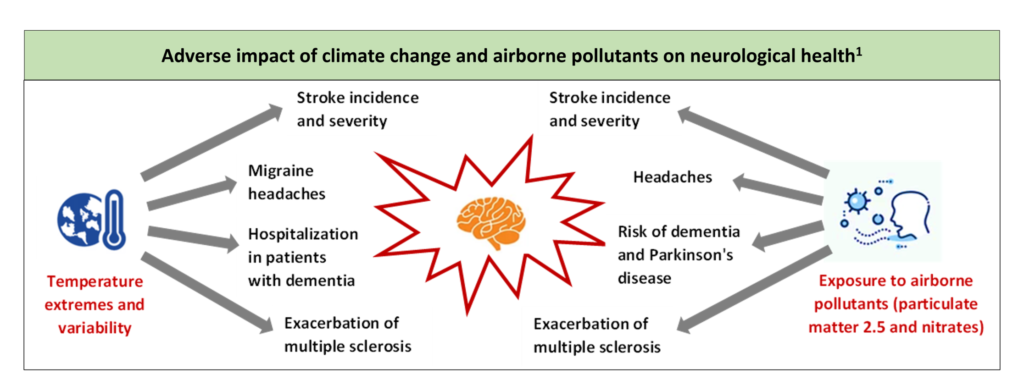
A recently published study in the journal, Neurology, reported increased incidence and severity of neurological diseases with climate change and exposure to air pollutants.A significant impact of climate change was observed on the main contributors of global neurological disease burden, i.e., migraine, stroke, and neurodegenerative disorders [1,2].
In the 21st century, climate change is a recognized startling phenomenon, which is happening at a faster rate, and humans are the main offenders for this occurrence. Global warming and air pollution are two serious consequences of climate change.A rise of 0.3⁰C–0.7⁰C every year in the global ambient temperature is expected for the next 30 years. Besides, recent reports have also documented increased rates of air pollution and associated mortality [2].
Gradual increase in ambient temperature and air pollution together has a significant negative impact on human health, including adverse impact on neurological health [1,2]. Climate change triggers various pathophysiological mechanisms involved in neurological disorders, including oxidative stress, changes in cardiovascular and cerebrovascular hemodynamics, excitotoxicity, microglial activation, and cellular apoptosis [2].
A review of 364 articles was carried out to assess the impact of extreme weather events, temperature fluctuations, and air pollutants on neurological diseases, their severity, and symptom exacerbations [1]. The key findings of the review are highlighted in the graphic below.

Clinical implication: Irreversible climate changes witnessed by humanity has resulted in a catastrophic situation [1,2]. Although negative effects of climate change and air pollution on human health are well-known, this study has thrown light on the increased risk of new-onset neurological diseases and worsening of existing ones, thereby highlighting the changing trends of neurological diseases with climate change. The results of this study emphasize on three important research priorities, viz., developing risk mitigation strategies for neuro-infectious diseases, understanding the pathophysiological mechanisms of airborne pollutants in the development of neurological diseases, and improving neurological care amidst the prevailing climate change [1]. At an individual level, it is highly important to limit the current rate of climate change [2].
References
1. Louis S, Carlson AK, Suresh A, et al. Impacts of climate change and air pollution on neurologic health, disease, and practice: A scoping review. Neurology. 2022:10.1212/WNL.0000000000201630. Doi: 10.1212/WNL.0000000000201630
2. Zammit C, Torzhenskaya N, Ozarkar PD, et al. Neurological disorders vis-à-vis climate change. Early Hum Dev. 2021;155:105217. Doi: 10.1016/j.earlhumdev.2020.105217
